A class of numerical methods for autonomous initial value problems
DOI:
https://doi.org/10.33993/jnaat411-970Keywords:
initial value problem, stability region, convergence order, local truncation errorAbstract
In this paper we introduce a class of explicit numerical methods for approximating the solutions of scalar initial value problems for first order differential equations, using a nonlinear interpolation formula. We show that the methods generated in this way can be identified as explicit Runge-Kutta methods and we analyze some particular cases. Finally, numerical examples are provided.Downloads
References
J.C. Butcher, Numerical Methods for Ordinary Differential Equations, John Wiley & Sons, 2008. https://doi.org/10.1002/9780470753767 DOI: https://doi.org/10.1002/9780470753767
M. Crouzeix and A.L. Mignot, Analyse numérique des equations différentielles, Masson, Paris, 1989.
J.D. Lambert, Numerical Methods for Ordinary Differential Systems-The Initial Value Problem, John Wiley & Sons, 1990.
F. Pătrulescu, A numerical method for the solution of an autonomous initial value problem, Carpathian J. Math., 28, no. 2, pp. 289-296, 2012. DOI: https://doi.org/10.37193/CJM.2012.02.05
I. Păvăloiu, On an approxiation formula, Rev. Anal. Numér. Théor. Approx., 26, no. 1--2, pp. 179-183, 1997, http://ictp.acad.ro/jnaat/journal/article/view/1997-vol26-nos1-2-art23
A. Ralston, Runge-Kutta methods with minimum error bounds, Math. Comp., 16, no. 80, pp. 431-437, 1962. https://doi.org/10.1090/s0025-5718-1962-0150954-0 DOI: https://doi.org/10.1090/S0025-5718-1962-0150954-0
J. F. Traub, Iterative Methods for the Solution of Equations, Prentice-Hall, Inc., Englewood Cliffs, N.J., 1964.
Published
Issue
Section
License
Copyright (c) 2015 Journal of Numerical Analysis and Approximation Theory

This work is licensed under a Creative Commons Attribution 4.0 International License.
Open Access. This article is distributed under the terms of the Creative Commons Attribution 4.0 International License, which permits unrestricted use, distribution, and reproduction in any medium, provided you give appropriate credit to the original author(s) and the source, provide a link to the Creative Commons license, and indicate if changes were made.










